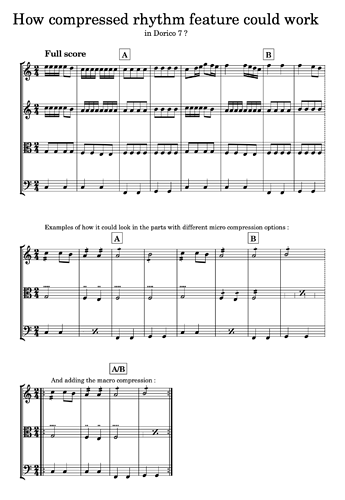Dear fellow Doricians, dear dev Team,
This is an idea I already talked about here quite some time ago, but only on the micro level…
It would be absolutely stunning to have a feature that, a little bit like the condensing feature, would allow automatically to “compress” rhythmically the parts, while leaving the full score intact. What I mean here is :
• micro : when there are repeated notes in a bar, automatically write the equivalent to shift-R, 1 or 2 or 3 (depending on the rhythmic value needed). When there are repeated bars, automatically change them with the % or 2% signs.
• macro : when some region gets repeated in a part (but it does not show in the score because of some instruments not using that repeat — I am (obviously) thinking of singers who do not sing the same things—, automatically Dorico would “recognize” the repeat structure and create it for the accurate parts only (with the 1st and 2nd time bars automatically created…) and the score remains intact.
Of course, these could be tweaked through a “compressing change” just very much like the Condensing change we’re used to, so that it can get very granular and precise.
This would be an amazing way to benefit from the abstraction levels Dorico uses.
Right now, I’ve been thinking how I could achieve those things. My answer would be : duplicate the flows where such compression could be applied, untick all the players not concerned by those, make sure I untick those new flows from the score layout, while unticking the original flows for the “compressed” players layouts. Then tweak the new flows so that the parts show what I want them to show. It’s possible, it keeps everything in the same file (so very useful when you have to correct things) but that’s some extra work, to gain some space on the parts pages and I would lose some dynamic linking (if I correct a part that is no longer in the score, it’s double work.).
Sometimes, that real estate does matter.
I hope you’ll like my little dream here.
